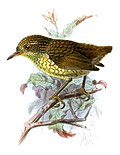| Lichenostomus | |
|---|---|
 | |
| Yellow-tufted honeyeater (Lichenostomus melanops) | |
| Scientific classification | |
| Kingdom: | Animalia |
| Phylum: | Chordata |
| Class: | Aves |
| Order: | Passeriformes |
| Family: | Meliphagidae |
| Genus: | Lichenostomus Cabanis, 1851 |
| Type species | |
| Lichenostomus occidentalis [1] Cabanis, 1851 | |
Lichenostomus is a genus of honeyeaters endemic to Australia.
The genus formerly contained twenty species but it was split after a molecular phylogenetic analysis published in 2011 showed that the genus was polyphyletic. [2] Former members were moved to the six new genera: Nesoptilotis , Bolemoreus , Caligavis , Stomiopera , Gavicalis and Ptilotula . [2]
The genus contains two species: [3]
| Image | Scientific name | Common name | Distribution |
|---|---|---|---|
 | Lichenostomus melanops | Yellow-tufted honeyeater | east and southeast Australia |
 | Lichenostomus cratitius | Purple-gaped honeyeater | southwest and south-central Australia |
The name Lichenostomus was introduced by the German ornithologist Jean Cabanis in 1851. [4] The word is derived from the Greek leikhēn meaning lichen or callous and stoma meaning mouth. [5]
